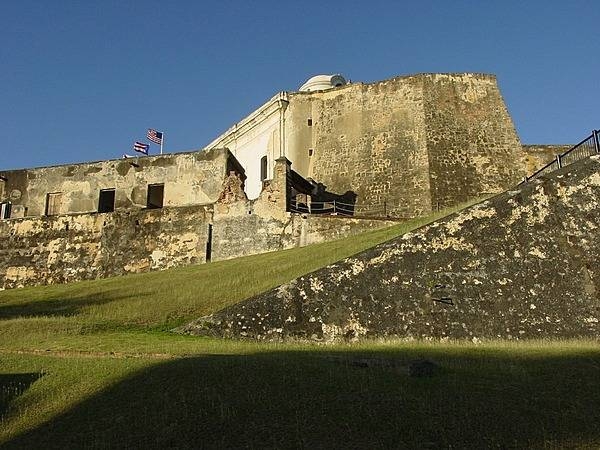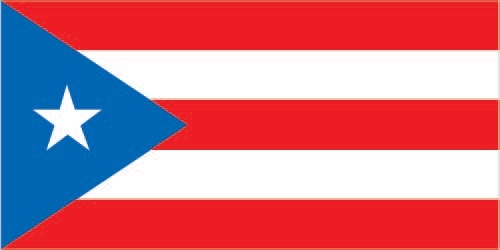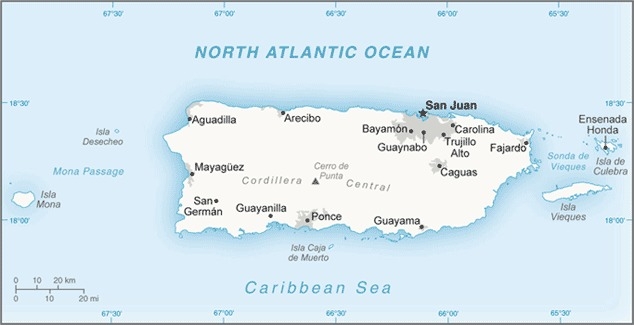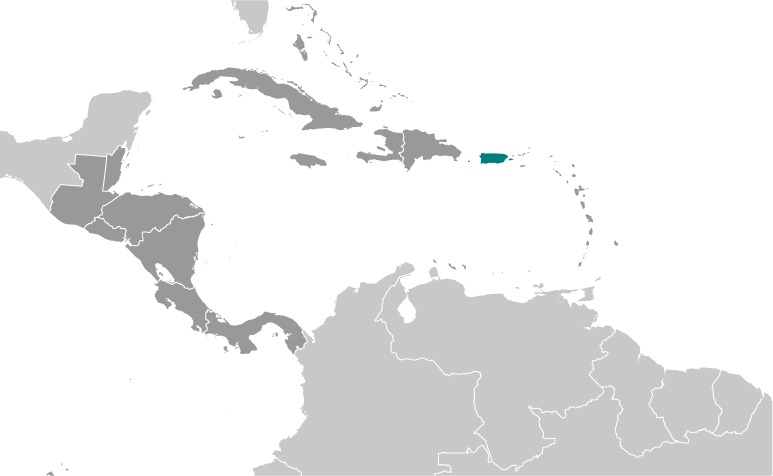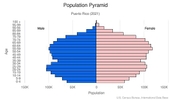Puerto Rico
Introduction
Background
Populated for centuries by aboriginal peoples, the island was claimed by the Spanish Crown in 1493 following Christopher COLUMBUS' second voyage to the Americas. In 1898, after 400 years of colonial rule that saw the indigenous population nearly exterminated and African slave labor introduced, Puerto Rico was ceded to the US as a result of the Spanish-American War. Puerto Ricans were granted US citizenship in 1917. Popularly elected governors have served since 1948. In 1952, a constitution was enacted providing for internal self-government. In plebiscites held in 1967, 1993, and 1998, voters chose not to alter the existing political status with the US, but the results of a 2012 vote left open the possibility of American statehood. Economic recession on the island has led to a net population loss since about 2005, as large numbers of residents moved to the US mainland. The trend has accelerated since 2010; in 2014, Puerto Rico experienced a net population loss to the mainland of 64,000, more than double the net loss of 26,000 in 2010. Hurricane Maria struck the island on 20 September 2017 causing catastrophic damage, including destruction of the electrical grid that had been cripled by Hurricane Irma just two weeks before. It was the worst storm to hit the island in eight decades, and damage is estimated in the tens of billions of dollars. A referendum held in late 2020 showed a narrow preference for American statehood.
Visit the Definitions and Notes page to view a description of each topic.
Geography
Location
Caribbean, island between the Caribbean Sea and the North Atlantic Ocean, east of the Dominican Republic
Geographic coordinates
18 15 N, 66 30 W
Map references
Central America and the Caribbean
Area - comparative
slightly less than three times the size of Rhode Island
Land boundaries
total: 0 km
Coastline
501 km
Maritime claims
territorial sea: 12 nm
exclusive economic zone: 200 nm
Climate
tropical marine, mild; little seasonal temperature variation
Terrain
mostly mountains with coastal plain in north; precipitous mountains to the sea on west coast; sandy beaches along most coastal areas
Elevation
highest point: Cerro de Punta 1,338 m
lowest point: Caribbean Sea 0 m
mean elevation: 261 m
Natural resources
some copper and nickel; potential for onshore and offshore oil
Land use
agricultural land: 22% (2018 est.)
arable land: 6.6% (2018 est.)
permanent crops: 5.6% (2018 est.)
permanent pasture: 9.8% (2018 est.)
forest: 63.2% (2018 est.)
other: 14.8% (2018 est.)
Irrigated land
220 sq km (2012)
Population distribution
population clusters tend to be found along the coast, the largest of these is found in and around San Juan; an exception to this is a sizeable population located in the interior of the island immediately south of the capital around Caguas; most of the interior, particularly in the western half of the island, is dominated by the Cordillera Central mountains, where population density is low
Natural hazards
periodic droughts; hurricanes
Geography - note
important location along the Mona Passage - a key shipping lane to the Panama Canal; San Juan is one of the biggest and best natural harbors in the Caribbean; many small rivers and high central mountains ensure land is well watered; south coast relatively dry; fertile coastal plain belt in north
People and Society
Nationality
noun: Puerto Rican(s) (US citizens)
adjective: Puerto Rican
Ethnic groups
White 75.8%, Black/African American 12.4%, other 8.5% (includes American Indian, Alaskan Native, Native Hawaiian, other Pacific Islander, and others), mixed 3.3% (2010 est.)
note: 99% of the population is Latino
Languages
Spanish, English
major-language sample(s):
La Libreta Informativa del Mundo, la fuente indispensable de información básica. (Spanish)
The World Factbook, the indispensable source for basic information.
Religions
Roman Catholic 56%, Protestant 33% (largely Pentecostal), other 2%, atheist 1%, none 7% (2014 est.)
Age structure
0-14 years: 14.22% (male 231,406/female 222,061)
15-24 years: 12.78% (male 207,169/female 200,373)
25-54 years: 37.73% (male 573,114/female 630,276)
55-64 years: 13.5% (male 197,438/female 232,931)
65 years and over: 21.77% (male 297,749/female 396,551) (2020 est.)
Dependency ratios
total dependency ratio: 57.7
youth dependency ratio: 24.8
elderly dependency ratio: 32.8
potential support ratio: 3 (2020 est.)
Median age
total: 43.6 years
male: 41.6 years
female: 45.3 years (2020 est.)
Population distribution
population clusters tend to be found along the coast, the largest of these is found in and around San Juan; an exception to this is a sizeable population located in the interior of the island immediately south of the capital around Caguas; most of the interior, particularly in the western half of the island, is dominated by the Cordillera Central mountains, where population density is low
Urbanization
urban population: 93.6% of total population (2021)
rate of urbanization: -0.12% annual rate of change (2020-25 est.)
Major urban areas - population
2.445 million SAN JUAN (capital) (2021)
Sex ratio
at birth: 1.06 male(s)/female
0-14 years: 1.04 male(s)/female
15-24 years: 1.03 male(s)/female
25-54 years: 0.91 male(s)/female
55-64 years: 0.85 male(s)/female
65 years and over: 0.75 male(s)/female
total population: 0.9 male(s)/female (2020 est.)
Maternal mortality ratio
21 deaths/100,000 live births (2017 est.)
country comparison to the world: 123Infant mortality rate
total: 6.16 deaths/1,000 live births
male: 6.73 deaths/1,000 live births
female: 5.55 deaths/1,000 live births (2021 est.)
Life expectancy at birth
total population: 81.47 years
male: 78.23 years
female: 84.89 years (2021 est.)
Drinking water source
improved: total: 97% of population
unimproved: total: 0% of population (2017 est.)
Physicians density
3.06 physicians/1,000 population (2018)
Sanitation facility access
improved: total: 97.2% of population
unimproved: total: 2.8% of population (2017 est.)
Literacy
definition: age 15 and over can read and write
total population: 92.4%
male: 92.4%
female: 92.4% (2017)
School life expectancy (primary to tertiary education)
total: 16 years
male: 15 years
female: 18 years (2018)
Unemployment, youth ages 15-24
total: 26.6%
male: 28.9%
female: 23.1% (2012 est.)
Environment
Environment - current issues
soil erosion; occasional droughts cause water shortages; industrial pollution
Climate
tropical marine, mild; little seasonal temperature variation
Land use
agricultural land: 22% (2018 est.)
arable land: 6.6% (2018 est.)
permanent crops: 5.6% (2018 est.)
permanent pasture: 9.8% (2018 est.)
forest: 63.2% (2018 est.)
other: 14.8% (2018 est.)
Urbanization
urban population: 93.6% of total population (2021)
rate of urbanization: -0.12% annual rate of change (2020-25 est.)
Revenue from forest resources
forest revenues: 0% of GDP (2018 est.)
country comparison to the world: 192Waste and recycling
municipal solid waste generated annually: 4,170,953 tons (2015 est.)
municipal solid waste recycled annually: 583,933 tons (2013 est.)
percent of municipal solid waste recycled: 14% (2013 est.)
Total water withdrawal
municipal: 796 million cubic meters (2017 est.)
industrial: 2.365 billion cubic meters (2017 est.)
agricultural: 113.5 million cubic meters (2017 est.)
Total renewable water resources
7.1 billion cubic meters (2017 est.)
Government
Country name
conventional long form: Commonwealth of Puerto Rico
conventional short form: Puerto Rico
abbreviation: PR
etymology: Christopher COLUMBUS named the island San Juan Bautista (Saint John the Baptist) and the capital city and main port Cuidad de Puerto Rico (Rich Port City); over time, however, the names were shortened and transposed and the island came to be called Puerto Rico and its capital San Juan
Government type
unincorporated organized territory of the US with local self-government; republican form of territorial government with separate executive, legislative, and judicial branches
Note: reference Puerto Rican Federal Relations Act, 2 March 1917, as amended by Public Law 600, 3 July 1950
Dependency status
unincorporated organized territory of the US; policy relations between Puerto Rico and the US conducted under the jurisdiction of the Office of the President
Capital
name: San Juan
geographic coordinates: 18 28 N, 66 07 W
time difference: UTC-4 (1 hour ahead of Washington, DC, during Standard Time)
etymology: the name dates to 1521 and the founding of the city under the name "Ciudad de San Juan Bautista de Puerto Rico" (City of Saint John the Baptist of Puerto Rico)
Administrative divisions
none (territory of the US); there are no first-order administrative divisions as defined by the US Government, but there are 78 municipalities (municipios, singular - municipio) at the second order; Adjuntas, Aguada, Aguadilla, Aguas Buenas, Aibonito, Anasco, Arecibo, Arroyo, Barceloneta, Barranquitas, Bayamon, Cabo Rojo, Caguas, Camuy, Canovanas, Carolina, Catano, Cayey, Ceiba, Ciales, Cidra, Coamo, Comerio, Corozal, Culebra, Dorado, Fajardo, Florida, Guanica, Guayama, Guayanilla, Guaynabo, Gurabo, Hatillo, Hormigueros, Humacao, Isabela, Jayuya, Juana Diaz, Juncos, Lajas, Lares, Las Marias, Las Piedras, Loiza, Luquillo, Manati, Maricao, Maunabo, Mayaguez, Moca, Morovis, Naguabo, Naranjito, Orocovis, Patillas, Penuelas, Ponce, Quebradillas, Rincon, Rio Grande, Sabana Grande, Salinas, San German, San Juan, San Lorenzo, San Sebastian, Santa Isabel, Toa Alta, Toa Baja, Trujillo Alto, Utuado, Vega Alta, Vega Baja, Vieques, Villalba, Yabucoa, Yauco
Independence
none (territory of the US with commonwealth status)
National holiday
US Independence Day, 4 July (1776); Puerto Rico Constitution Day, 25 July (1952)
Constitution
history: previous 1900 (Organic Act, or Foraker Act); latest ratified by referendum 3 March 1952, approved 3 July 1952, effective 25 July 1952
amendments: proposed by a concurrent resolution of at least two-thirds majority by the total Legislative Assembly membership; approval requires at least two-thirds majority vote by the membership of both houses and approval by a majority of voters in a special referendum; if passed by at least three-fourths Assembly vote, the referendum can be held concurrently with the next general election; constitutional articles such as the republican form of government or the bill of rights cannot be amended; amended 1952
Legal system
civil law system based on the Spanish civil code and within the framework of the US federal system
Citizenship
see United States
Suffrage
18 years of age; universal; note - island residents are US citizens but do not vote in US presidential elections
Executive branch
chief of state: President Joseph R. BIDEN Jr. (since 20 January 2021); Vice President Kamala D. HARRIS (since 20 January 2021)
head of government: Governor Pedro PIERLUISI (since 2 January 2021)
cabinet: Cabinet appointed by governor with the consent of the Legislative Assembly
elections/appointments: president and vice president indirectly elected on the same ballot by an Electoral College of 'electors' chosen from each state; president and vice president serve a 4-year term (eligible for a second term); under the US Constitution, residents of Puerto Rico do not vote in elections for US president and vice president; however, they may vote in Democratic and Republican party presidential primary elections; governor directly elected by simple majority popular vote for a 4-year term (no term limits); election last held on 3 November 2020 (next to be held on November 2024)
election results: Pedro PIERLUISI elected governor; percent of vote - Pedro PIERLUISI (PNP) 32.9%, Carlos DELGADO (PPD) 31.6%, Alexandra LUGARO (independent) 14.2%, Juan DALMAU (PIP) 13.7%
note: on 24 July 2019, Governor Ricardo ROSSELLO announced his resignation effective 2 August 2019; as Secretary of State, Pedro PIERLUISI succeeded Governor Ricardo ROSSELLO; on 7 August 2019 the Supreme Court of Puerto Rico ruled Pedro PIERLUISI accession was unconstitutional and Wanda VAZQUEZ is sworn in as governor
Legislative branch
description: bicameral Legislative Assembly or Asamblea Legislativa consists of:
Senate or Senado (30 seats; 16 members directly elected in 8 2-seat constituencies by simple majority vote and 14 at-large members directly elected by simple majority vote to serve 4-year terms)
House of Representatives or Camara de Representantes (51 seats; members directly elected in single-seat constituencies by simple majority vote to serve 4-year terms)
elections:
Senate - last held on 8 November 2016 (next to be held on 3 November 2020)
House of Representatives - last held on 8 November 2016 (next to be held on 3 November 2020)
election results:
Senate - percent of vote by party - NA; seats by party - PNP 21, PPD 7, PIP 1, Independent 1; composition - men 23, women 7, percent of women 23.3%
House of Representatives - percent of vote by party - NA; seats by party - PNP 34, PPD 16, PIP 1; composition - men 11, women 4, percent of women 26.7%; total Legislative Assembly percent of women 16%
note: Puerto Rico directly elects 1 member by simple majority vote to serve a 4-year term as a commissioner to the US House of Representatives; the commissioner can vote when serving on a committee and when the House meets as the Committee of the Whole House but not when legislation is submitted for a 'full floor' House vote; election of commissioner last held on 6 November 2018 (next to be held in November 2022)
Judicial branch
highest courts: Supreme Court (consists of the chief justice and 8 associate justices)
judge selection and term of office: justices appointed by the governor and confirmed by majority Senate vote; judges serve until compulsory retirement at age 70
subordinate courts: Court of Appeals; First Instance Court comprised of superior and municipal courts
Political parties and leaders
National Democratic Party [Charlie RODRIGUEZ]
National Republican Party of Puerto Rico [Jenniffer GONZALEZ]
New Progressive Party or PNP [Ricardo ROSSELLO] (pro-US statehood)
Popular Democratic Party or PPD [Alejandro GARCIA Padillo] (pro-commonwealth)
Puerto Rican Independence Party or PIP [Ruben BERRIOS Martinez] (pro-independence)
International organization participation
AOSIS (observer), Caricom (observer), Interpol (subbureau), IOC, UNWTO (associate), UPU, WFTU (NGOs)
Diplomatic representation in the US
none (territory of the US)
Diplomatic representation from the US
embassy: none (territory of the US with commonwealth status)
Flag description
five equal horizontal bands of red (top, center, and bottom) alternating with white; a blue isosceles triangle based on the hoist side bears a large, white, five-pointed star in the center; the white star symbolizes Puerto Rico; the three sides of the triangle signify the executive, legislative and judicial parts of the government; blue stands for the sky and the coastal waters; red symbolizes the blood shed by warriors, while white represents liberty, victory, and peace
note: design initially influenced by the US flag, but similar to the Cuban flag, with the colors of the bands and triangle reversed
National symbol(s)
Puerto Rican spindalis (bird), coqui (frog); national colors: red, white, blue
National anthem
name: "La Borinquena" (The Puerto Rican)
lyrics/music: Manuel Fernandez JUNCOS/Felix Astol ARTES
note: music adopted 1952, lyrics adopted 1977; the local anthem's name is a reference to the indigenous name of the island, Borinquen; the music was originally composed as a dance in 1867 and gained popularity in the early 20th century; there is some evidence that the music was written by Francisco RAMIREZ; as a commonwealth of the US, "The Star-Spangled Banner" is official (see United States)
Economy
Economic overview
Puerto Rico had one of the most dynamic economies in the Caribbean region until 2006; however, growth has been negative for each of the last 11 years. The downturn coincided with the phaseout of tax preferences that had led US firms to invest heavily in the Commonwealth since the 1950s, and a steep rise in the price of oil, which generates most of the island's electricity.
Diminished job opportunities prompted a sharp rise in outmigration, as many Puerto Ricans sought jobs on the US mainland. Unemployment reached 16% in 2011, but declined to 11.5% in December 2017. US minimum wage laws apply in Puerto Rico, hampering job expansion. Per capita income is about two-thirds that of the US mainland.
The industrial sector greatly exceeds agriculture as the locus of economic activity and income. Tourism has traditionally been an important source of income with estimated arrivals of more than 3.6 million tourists in 2008. Puerto Rico's merchandise trade surplus is exceptionally strong, with exports nearly 50% greater than imports, and its current account surplus about 10% of GDP.
Closing the budget deficit while restoring economic growth and employment remain the central concerns of the government. The gap between revenues and expenditures amounted to 0.6% of GDP in 2016, although analysts believe that not all expenditures have been accounted for in the budget and a better accounting of costs would yield an overall deficit of roughly 5% of GDP. Public debt remained steady at 92.5% of GDP in 2017, about $17,000 per person, or nearly three times the per capita debt of the State of Connecticut, the highest in the US. Much of that debt was issued by state-run schools and public corporations, including water and electric utilities. In June 2015, Governor Alejandro GARCIA Padilla announced that the island could not pay back at least $73 billion in debt and that it would seek a deal with its creditors.
Hurricane Maria hit Puerto Rico square on in September 2017, causing electrical power outages to 90% of the territory, as well as extensive loss of housing and infrastructure and contamination of potable water. Despite massive efforts, more than 40% of the territory remained without electricity as of yearend 2017. As a result of the destruction, many Puerto Ricans have emigrated to the US mainland.
Real GDP (purchasing power parity)
$106.82 billion note: data are in 2017 dollars (2020 est.)
$111.16 billion note: data are in 2017 dollars (2019 est.)
$109.53 billion note: data are in 2017 dollars (2018 est.)
note: data are in 2017 dollars
Real GDP growth rate
-2.4% (2017 est.)
-1.3% (2016 est.)
-1% (2015 est.)
Real GDP per capita
$33,400 note: data are in 2017 dollars (2020 est.)
$34,800 note: data are in 2017 dollars (2019 est.)
$34,300 note: data are in 2017 dollars (2018 est.)
note: data are in 2017 dollars
GDP (official exchange rate)
$104.2 billion (2017 est.)
Inflation rate (consumer prices)
1.8% (2017 est.)
-0.3% (2016 est.)
Credit ratings
Standard & Poors rating: D (2015)
GDP - composition, by sector of origin
agriculture: 0.8% (2017 est.)
industry: 50.1% (2017 est.)
services: 49.1% (2017 est.)
GDP - composition, by end use
household consumption: 87.7% (2017 est.)
government consumption: 12.2% (2017 est.)
investment in fixed capital: 11.7% (2017 est.)
investment in inventories: 0.5% (2017 est.)
exports of goods and services: 117.8% (2017 est.)
imports of goods and services: -129.8% (2017 est.)
Agricultural products
milk, plantains, bananas, poultry, tomatoes, mangoes/guavas, eggs, oranges, gourds, papayas
Industries
pharmaceuticals, electronics, apparel, food products, tourism
Labor force - by occupation
agriculture: 2.1%
industry: 19%
services: 79% (2005 est.)
Household income or consumption by percentage share
lowest 10%: NA
highest 10%: NA
Budget
revenues: 9.268 billion (2017 est.)
expenditures: 9.974 billion (2017 est.)
Fiscal year
1 July - 30 June
Exports - partners
Italy 15%, Netherlands 15%, Belgium 9%, Japan 8%, Germany 8%, Austria 8%, Spain 7%, China 5% (2019)
Exports - commodities
packaged medicines, medical cultures/vaccines, hormones, orthopedic and medical appliances, sulfur compounds (2019)
Imports - partners
Ireland 38%, Singapore 9%, Switzerland 8%, South Korea 5% (2019)
Imports - commodities
nitrogen compounds, sulfur compounds, refined petroleum, medical cultures/vaccines, cars (2019)
Debt - external
$56.82 billion (31 December 2010 est.)
$52.98 billion (31 December 2009 est.)
Exchange rates
the US dollar is used
Unemployment, youth ages 15-24
total: 26.6%
male: 28.9%
female: 23.1% (2012 est.)
Energy
Electricity access
electrification - total population: 100% (2020)
Electricity - installed generating capacity
6.294 million kW (2016 est.)
country comparison to the world: 76Electricity - from fossil fuels
94% of total installed capacity (2016 est.)
country comparison to the world: 47Electricity - from nuclear fuels
0% of total installed capacity (2017 est.)
country comparison to the world: 168Electricity - from hydroelectric plants
2% of total installed capacity (2017 est.)
country comparison to the world: 142Electricity - from other renewable sources
4% of total installed capacity (2017 est.)
country comparison to the world: 116Refined petroleum products - consumption
98,000 bbl/day (2016 est.)
country comparison to the world: 81Communications
Telephones - fixed lines
total subscriptions: 711,512 (2020)
subscriptions per 100 inhabitants: 24.87 (2020 est.)
Telephones - mobile cellular
total subscriptions: 3,483,570 (2020)
subscriptions per 100 inhabitants: 121.8 (2020 est.)
Telecommunication systems
general assessment: small telecom market affected by mismanagement and natural disasters; hurricanes in 2017 and earthquake in 2020 caused destruction of telecom infrastructure, leading to market decline; US provided funds to rebuild after some delay; lags behind US in fixed and broadband penetration due to high unemployment and lack of operator investment; multi-national telcoms enable LTE and launch of 5G; growing number of submarine cables helps to reduce costs and supports streaming of international content and cloud services; operator launched connectivity for school children during pandemic (2020)
domestic: digital telephone system; mobile-cellular services; fixed-line 23 per 100 and mobile-cellular 115 per 100 persons (2019)
international: country code - 1-787, 939; landing points for the GTMO-PR, AMX-1, BRUSA, GCN, PCCS, SAm-1, Southern Caribbean Fiber, Americas-II, Antillas, ARCOS, SMPR-1, and Taino-Carib submarine cables providing connectivity to the mainland US, Caribbean, Central and South America; satellite earth station - 1 Intelsat (2019)
note: the COVID-19 pandemic continues to have a significant impact on production and supply chains globally; since 2020, some aspects of the telecom sector have experienced downturn, particularly in mobile device production; many network operators delayed upgrades to infrastructure; progress towards 5G implementation was postponed or slowed in some countries; consumer spending on telecom services and devices was affected by large-scale job losses and the consequent restriction on disposable incomes; the crucial nature of telecom services as a tool for work and school from home became evident, and received some support from governments
Broadcast media
more than 30 TV stations operating; cable TV subscription services are available; roughly 125 radio stations
Internet users
total: 2.21 million (2021 est.)
percent of population: 77.74% (2019 est.)
Broadband - fixed subscriptions
total: 671,284 (2020)
subscriptions per 100 inhabitants: 23.46 (2020 est.)
Transportation
Airports - with paved runways
total: 17
over 3,047 m: 2
2,438 to 3,047 m: 1
1,524 to 2,437 m: 2
914 to 1,523 m: 7
under 914 m: 5 (2017)
Airports - with unpaved runways
total: 12
1,524 to 2,437 m: 1
914 to 1,523 m: 1
under 914 m: 10 (2013)
Roadways
total: 26,862 km (includes 454 km of expressways) (2012)
country comparison to the world: 102Ports and terminals
major seaport(s): Ensenada Honda, Mayaguez, Playa de Guayanilla, Playa de Ponce, San Juan
container port(s) (TEUs): San Juan (2,142,662) (2019)
LNG terminal(s) (import): Guayanilla Bay
Military and Security
Military and security forces
no regular indigenous military forces; National Guard, State Guard, Police Force
Military - note
defense is the responsibility of the US
Transnational Issues
Disputes - international
increasing numbers of illegal migrants from the Dominican Republic cross the Mona Passage to Puerto Rico each year looking for work
